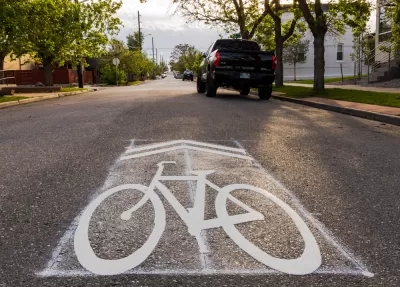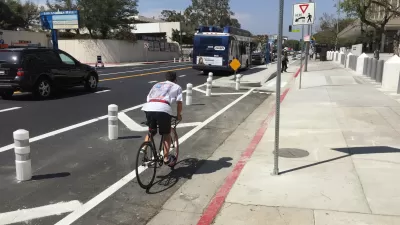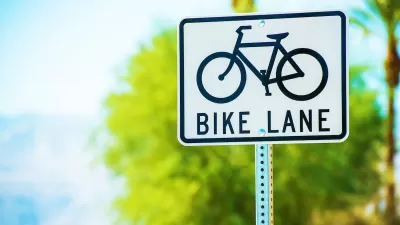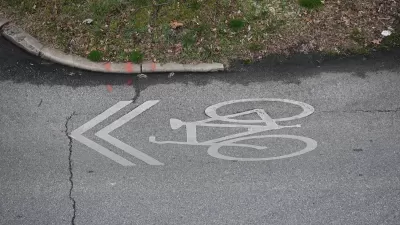The painted symbols can not only fail to protect bike riders, but can actually make riding conditions less safe.

An article written by Momentum Magazine staff argues that sharrows, once believed to be an effective way to remind drivers to share the road with bikes, are at best ineffective and at worst downright dangerous.
If you’re unfamiliar with these sad, lonely symbols, they’re those little bike-shaped icons painted onto roads that are supposed to indicate where cyclists should ride. But in reality, they’re about as effective as trying to protect yourself from a charging rhino with a wet paper towel.
According to the article, “Studies have shown that sharrows don’t actually provide any real safety benefits for cyclists. In fact, they may even make things worse by encouraging drivers to pass cyclists too closely.” Planetizen previously covered this shift in mindset, when People For Bikes senior director Dave Snyder admitted in an opinion piece that he “was wrong” when he enthusiastically supported sharrows decades ago.
“Time and time again, research demonstrates that sharrows are ineffective at improving cyclist safety.” In fact, “We know now that even actual bike lanes painted in some eye-catching hue do not provide enough safety for cyclists.” In the worst cases sharrows can engender a “false sense of security” and encourage drivers to pass too closely and cyclists to ride too close to parked cars.
As bike advocates regularly explain, “The best bicycle infrastructure for safe cycling is dedicated bike lanes that provide physical separation between cyclists and vehicles,” which can reduce the risk of injury for cyclists by as much as 90 percent, according to one study. Bike lanes are also shown to boost sales for local businesses, and naturally reduce carbon emissions when replacing car trips. As Snyder and other advocates argue, cities should invest in bike infrastructure that truly protects bike riders, other street users, and the environment.
FULL STORY: Sharrows used to make sense in theory, but are now useless and possibly dangerous in practice

Study: Maui’s Plan to Convert Vacation Rentals to Long-Term Housing Could Cause Nearly $1 Billion Economic Loss
The plan would reduce visitor accommodation by 25,% resulting in 1,900 jobs lost.

Alabama: Trump Terminates Settlements for Black Communities Harmed By Raw Sewage
Trump deemed the landmark civil rights agreement “illegal DEI and environmental justice policy.”

Why Should We Subsidize Public Transportation?
Many public transit agencies face financial stress due to rising costs, declining fare revenue, and declining subsidies. Transit advocates must provide a strong business case for increasing public transit funding.

Paris Bike Boom Leads to Steep Drop in Air Pollution
The French city’s air quality has improved dramatically in the past 20 years, coinciding with a growth in cycling.

Why Housing Costs More to Build in California Than in Texas
Hard costs like labor and materials combined with ‘soft’ costs such as permitting make building in the San Francisco Bay Area almost three times as costly as in Texas cities.

San Diego County Sees a Rise in Urban Coyotes
San Diego County experiences a rise in urban coyotes, as sightings become prevalent throughout its urban neighbourhoods and surrounding areas.
Urban Design for Planners 1: Software Tools
This six-course series explores essential urban design concepts using open source software and equips planners with the tools they need to participate fully in the urban design process.
Planning for Universal Design
Learn the tools for implementing Universal Design in planning regulations.
Smith Gee Studio
Alamo Area Metropolitan Planning Organization
City of Santa Clarita
Institute for Housing and Urban Development Studies (IHS)
City of Grandview
Harvard GSD Executive Education
Toledo-Lucas County Plan Commissions
Salt Lake City
NYU Wagner Graduate School of Public Service





























